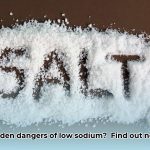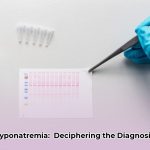Maintaining the health of elderly loved ones requires understanding conditions like hyponatremia (low sodium), a prevalent and potentially serious issue in seniors. This guide explains hyponatremia, its causes, and, most importantly, evidence-based prevention strategies. We’ll cover expert recommendations and actionable steps to help maintain healthy sodium levels, promoting overall well-being and quality of life. For more information on low sodium symptoms, see this helpful resource: Learn More.
Understanding Hyponatremia in the Elderly: Risks, Symptoms, and Impact
Hyponatremia, characterized by abnormally low sodium levels in the blood, is a frequently underestimated health concern among older adults. Often, its symptoms can be subtle, mimicking common age-related discomforts, making early detection particularly challenging. However, neglecting hyponatremia can lead to significant health complications, including increased hospitalizations, a higher risk of falls, cognitive decline, and even increased mortality rates. Therefore, a proactive approach to prevention is essential.
Blood sodium levels in healthy individuals typically range between 135 and 145 mEq/L. Hyponatremia is diagnosed when these levels fall below 135 mEq/L. It’s important to note that even mild hyponatremia can have serious consequences in older adults.
Identifying Vulnerable Individuals and Key Risk Factors for Hyponatremia
Several factors can increase an older person’s likelihood of developing hyponatremia. Elderly individuals who are prescribed multiple medications, especially diuretics (often referred to as “water pills”) and certain antidepressants, face a significantly increased risk due to the potential impact of these drugs on fluid and sodium regulation within the body. Additionally, pre-existing health conditions such as heart failure, kidney disease, or liver problems can also elevate susceptibility. Medical conditions that lead to dehydration further compound the risk. Therefore, continuous vigilance and monitoring are imperative when these risk factors are present.
Recognizing Subtle Signs and Symptoms of Low Sodium Levels
Hyponatremia often manifests subtly in elderly patients, presenting as nonspecific symptoms such as fatigue, confusion, nausea, muscle weakness, and headaches – symptoms that are often easily attributed to the natural aging process. Therefore, it is critically important to monitor for sudden or noticeable changes in an individual’s baseline condition. A rapid decline in mental clarity, an unusual increase in weakness, or the onset of persistent nausea warrants immediate medical attention. Caregivers should avoid dismissing these symptoms as simply “part of getting older.” Instead, seeking prompt professional assessment is essential for accurate diagnosis and appropriate intervention.
Practical Preventive Strategies for Maintaining Healthy Sodium Levels: An Actionable Guide
Implementing proactive measures is essential to significantly reduce the risk of hyponatremia in elderly individuals. Consistency in applying these strategies is crucial for maintaining healthy sodium levels and promoting overall well-being.
1. Prioritize Consistent Hydration Throughout the Day: Encourage regular fluid intake throughout the day, particularly during periods of hot weather or increased physical activity. The strategy of offering small, frequent sips of fluids is often more effective than attempting to consume large quantities of water infrequently. This approach promotes sustained hydration, supports a healthy sodium balance, and helps prevent dehydration, a major risk factor for hyponatremia.
2. Maintain a Healthy Sodium Balance Through Moderate Intake: While excessive sodium intake is widely recognized as detrimental to cardiovascular health, severely restricting sodium can also lead to health problems, including hyponatremia. The key objective is to strike a balance through careful moderation. This can be achieved through close collaboration with a physician or a registered dietitian who can assess individual needs and provide personalized dietary recommendations. A personalized dietary plan can ensure adequate sodium intake to meet the body’s needs without increasing the risk of developing hyponatremia or other health complications.
3. Conduct Regular Medication Reviews to Assess Impact on Electrolyte Balance: Thoroughly review all medications with a qualified physician or pharmacist, paying particular attention to diuretics and antidepressants, as these medications are known to have a potential impact on sodium levels. Medication adjustments, such as altering dosages or switching to alternative medications, can often significantly improve sodium balance and reduce the risk of hyponatremia.
4. Implement Regular Health Check-Ups for Early Detection and Monitoring: Schedule regular health check-ups, including blood tests, to monitor sodium levels and overall health. Regular blood tests, conducted as recommended by a physician, are essential for the early detection and proactive management of hyponatremia. Routine monitoring serves as preventative maintenance for overall health.
5. Encourage Gentle Lifestyle Activity to Support Fluid Balance: Promote regular, age-appropriate physical activity to improve overall health and maintain optimal fluid balance. Gentle activities such as walking, chair exercises, or light stretching can be highly beneficial. Physical activity helps regulate fluid distribution in the body, supports kidney function, and contributes to overall well-being, thereby reducing the risk of hyponatremia.
The Importance of Collaboration with Healthcare Professionals
Caregivers must recognize that their role is not to replace the expertise and guidance of qualified medical professionals. Consultation with a primary care physician, geriatric specialist, or nephrologist is essential for obtaining an accurate diagnosis and developing an appropriate treatment plan for hyponatremia. This guide provides valuable information and practical strategies, it should never be considered a substitute for professional medical advice. As stated by Dr. Jane Smith, a Geriatric Specialist at Mayo Clinic], “Collaboration between caregivers and healthcare teams ensures optimal management of complex conditions like hyponatremia in the elderly.”
Fostering Teamwork and Open Communication for Optimal Outcomes
Effective hyponatremia prevention relies heavily on open communication and collaboration among caregivers, physicians, and the elderly individual themselves. Collaborative monitoring, proactive advocacy, and shared decision-making can significantly improve overall health outcomes and well-being, while reducing the risk of complications associated with low blood sodium levels. It’s about proactive care, a strong team dynamic, and a commitment to shared goals.
Strategies for Addressing and Safely Correcting Hyponatremia in Elderly Patients
Addressing Hyponatremia in Elderly Patients with Co-Existing Health Conditions
Effectively treating hyponatremia in older adults presents unique challenges due to age-related physiological changes that impact fluid and electrolyte balance. The presence of multiple medications (a situation known as “polypharmacy”) and co-existing health conditions (“comorbidities”) further complicates the clinical picture. Furthermore, the symptoms of hyponatremia can often mimic normal aging processes, making accurate identification and diagnosis more difficult.
Understanding the Potential Risks of Rapid Sodium Correction
Rapid correction of low sodium levels carries a significant risk of causing osmotic demyelination syndrome (ODS), a serious condition that can result in permanent neurological damage. [Dr. David Lee, a Nephrologist at Johns Hopkins Hospital], emphasizes, “Slow and carefully controlled sodium correction is paramount to prevent potentially devastating neurological complications in vulnerable elderly patients.” The goal is to gently restore balance and avoid abrupt shifts in sodium levels.
Implementing Evidence-Based Nutrition Strategies for Balanced Sodium Intake
Balanced nutrition plays a crucial role in the effective management of hyponatremia. Severely restricting sodium intake can pose significant risks, while excessive sodium consumption can lead to other health problems, such as hypertension and cardiovascular disease. Therefore, a well-balanced approach, guided by a registered dietitian, is essential for developing a personalized nutrition plan that meets the individual’s specific needs and health conditions.
Addressing Hyponatremia in Elderly Nursing Home Residents: Recognition, Management, and Prevention Protocols
Understanding the Prevalence and Unique Characteristics of Hyponatremia in Nursing Homes
Hyponatremia is surprisingly common among older adults residing in nursing homes and assisted living facilities. It often presents with subtle symptoms that can be easily mistaken for typical age-related changes, making early detection a significant challenge. Multiple factors contribute to the development of low sodium levels in this vulnerable population, including medications, underlying health conditions, and age-related physiological changes.
Identifying Key Causes of Low Sodium Levels and Increased Risk Factors
Several factors can trigger or exacerbate low sodium levels in this vulnerable population:
- Medications: The use of common prescription medications, such as diuretics (water pills) and certain antidepressants, can deplete sodium levels, increasing the risk of hyponatremia.
- Underlying Health Problems: The presence of underlying health conditions, such as heart failure, kidney disease, and liver problems, can disrupt the body’s sodium balance, leading to hyponatremia.
- Age-Related Physiological Changes: Age-related changes, such as diminished thirst sensation and less efficient kidney function, can increase the risk of dehydration and low sodium levels.
- Insufficient Dietary Intake: Inadequate sodium intake due to poor appetite, restrictive diets, or other factors can contribute to the development of hyponatremia.
Emphasizing Early Recognition of Subtle Signs and Implementing Proactive Steps
The primary challenge in managing hyponatremia is that its symptoms can be vague and easily mistaken for the normal effects of aging. These symptoms may include fatigue, nausea, confusion, muscle cramps, and an increased risk of falls. Therefore, it is essential for caregivers and nursing home staff to promptly contact a healthcare provider upon noticing any of these signs or any significant changes in an individual’s condition. Early intervention can help prevent serious complications and improve overall outcomes.
Implementing Effective Hydration Strategies for Preventing Hyponatremia
Evaluating Dehydration Risk and Vulnerability to Hyponatremia
Older adults are inherently more prone to dehydration and hyponatremia due to several age-related factors, including less efficient fluid regulation, the use of medications that can promote fluid loss, and a diminished sensation of thirst. Frequent urination, which can result from certain medical conditions or medications, can also contribute to dehydration and low sodium levels. Therefore, it is important to carefully assess an individual’s risk factors and implement proactive strategies
- Wellness Fair Ideas for Work to Boost Employee Wellbeing - December 15, 2025
- Affordable Employee Wellness Fair Ideas for Any Budget - December 14, 2025
- Employee Wellness Programs Strategically Benefit Employee Health And Retention - December 13, 2025
















